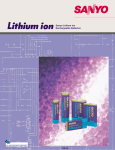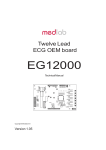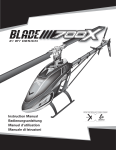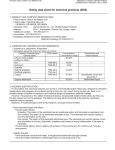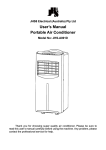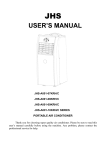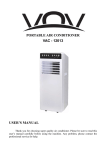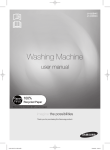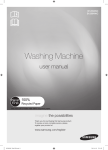Download Sanyo SEB-014 User's Manual
Transcript
Sanyo Lithium Polymer Rechargeable Batteries SEB-014 New generation rechargeable battery that technology of completely gel-type electrolyte with high ion conductivity brings Lithium Polymer Battery Presently, demand is rising rapidly for lightweight and thin portable information & communication devices such as portable phones, portable audio systems and PDA (personal digital assistants). Similarly, there is demand for thin and lightweight batteries for use in these devices. SANYO's lithium polymer battery can be utilized in a wide variety of market products. SANYO has developed, and introduces a lithium polymer battery that achieves an ultra-thin under 4mm with high performance through its own original technology and high reliability employing a complete gel-type electrolyte. Lithium polymer battery is new generation rechargeable battery to meet the demands of evolution to various, thinner and lighter battery. Model of Gel-type Electrolyte Structure model of electrolyte geled by cross-linked polymer Main Features High Performance and High Reliability with Newly Developed Complete Gel Type Electrolyte Electrolyte Cross-linked Polymer Structure of Lithium Polymer Battery The newly developed polymer electrolyte obtains superb long life reliability, featuring more than 500 recharging cycles while also achieving high performance (gravimetric energy density of 166Wh/kg & volumetric energy density of 348Wh/l). Excellent Discharge Characteristics that Allow for Discharge at 20°C Typical points of weakness for lithium polymer batteries were its load and temperature characteristics. This newly developed polymer electrolyte possesses high ion conductivity even at low temperatures, thus making possible discharges at 20°C. Cross section Casing / Aluminum laminate film Positive electrode collector Positive electrode Gel type electrolyte Separator Negative electrode Negative electrode collector Achieves an Ultra-Thin Type Thickness of Under 4mm It was possible to achieve both an ultra-thin type thickness of under 4mm and obtain high leakage-resistance even when utilizing thin and light aluminum laminated film as the exterior packaging material because the electrolyte is completely gel-type. Lithium Polymer Charge Characteristics 4.5 Discharge Rate Characteristics Temp.:20oC Charge : CC-CV 500mA-4.2V (It/20 cut off) Charge : CC-CV 500mA-4.2V (It/20 cut off) Discharge : CC 500mA (x0.2, x1, x2) (2.75V cut off) 1000 o Temp.:20 C 600 Capacity 3.0 400 2.5 200 600 400 4.0 Cell Voltage / V 3.5 800 Capacity / mAh 800 4.0 Current / mA Cell Voltage / V Cell Voltage It 3.5 It It 3.0 200 Current 2.0 0 30 60 90 120 150 0 2.5 0 100 200 Charge Time / min 400 500 600 Discharge Temperature Characteristics Charge : CC-CV 500mA-4.2V (It/20 cut off) Discharge : CC 500mA (2.75V cut off) Charge : CC-CV 500mA-4.2V (It/20 cut off) Discharge : CC 500mA (2.75V cut off) o Temp.:20 C 4.0 500 Cell Voltage / V Discharge Capacity / mAh Cycle Characteristics 600 300 Discharge Capacity / mAh 400 300 200 3.5 3.0 100 0 0 100 200 300 400 2.5 500 0 100 200 300 400 500 600 Discharge Capacity / mAh Cycle Number / - Ratings Model Number Nominal Nominal Voltage / V Capacity*1/ mAh Weight / g Size*2(H W L) / mm Energy / Wh Volumetric Energy Density Wh / I Gravimetric Energy Density Wh / kg UPF323456L 3.7 500 13.3 3.25 34.0 56.0 1.85 299 139 UPF383456L 3.7 640 14.5 3.90 34.0 56.0 2.37 319 163 UPF363562 3.7 620 15.4 3.70 34.7 61.0 2.29 293 149 UPF373581 3.7 940 21.0 3.60 34.5 80.5 3.48 348 166 *1: Discharge:0.2ItA(E.V.=2.75V)/Min. *2: The maximum thickness of the standard shipment charging condition. Applications Cellular phone PHS PDA Digital camera Head set stereo Notebook computer CD player Personal transceivers Handy terminal Mini Disc player etc. L Type Cell (PCB*-less type) The batteries attached L at their suffix are high safety models which are used our original super-efficient Manganese in the positive electrode. As they can prevent the unsafe situation at the over-charging, these cells can be attached to equipments without PCB. However, they are recommended to assemble protection devices or to install measures in order to protect from the over-current and the over-discharge mode when they are used without PCB. *: Protection Circuit Board Camcorder Lithium Polymer Battery Handling Precautions Danger 1 Do not disassemble or modify the battery pack. The battery pack is equipped with built-in safety/protection features. Should these features be disabled, the battery pack can damage, overheat, emit smoke, burst and/or ignite. 2 Do not connect the positive (+) and negative (–) terminals with a metal object such as wire. Do not transport or store the battery pack together with metal objects such as necklaces, hair pins, etc. Otherwise, short-circuiting will occur, overcurrent will flow, causing the battery pack to damage, overheat, emit smoke, burst and/or ignite, or the metal object such as wire, necklace or hair pin can generate heat. 3 Do not discard the battery pack into fire or heat it. Otherwise, its insulation can melt down, safety features will be damaged and/or its electrolyte can ignite, possibly leading to damage, overheating, smoke emission, bursting and/or ignition on it. 4 Do not use or leave the battery pack near a heat source such as fire or heater (80°C or higher). If the resin separator should be damaged owing to overheating, internal short-circuiting may occur to the battery pack, possibly leading to damage, overheating, smoke emission, bursting and/or ignition of the battery pack. 5 Do not immerse the battery pack in water or seawater, and do not allow it to get wet. Otherwise, the protective features in it can be damaged, it can be charged with extremely high current and voltage, abnormal chemical reactions may occur in it, possibly leading to damage, overheating, smoke emission, bursting and/or ignition. 6 Do not recharge the battery pack near fire or in extremely hot weather. Otherwise, hot temperatures can trigger its built-in protective features, inhibiting recharging, or can damage the built-in protective features, causing it to be charged with an extremely high current and voltage, and, as a result, abnormal chemical reactions can occur in it, possibly leading to damage, overheating, smoke emission, bursting and/or ignition. 7 To recharge the battery pack, use the battery charger specifically designed for the purpose and observe the recharging conditions specified by SANYO. A recharging operation under non-conforming recharging conditions (higher temperature and larger voltage/current than specified, modified battery charger, etc.) can cause the battery pack to be overcharged, or charged with extremely high current, abnormal chemical reaction can occur in it, possibly leading to damage, overheating, smoke emission, bursting and/or ignition. 8 Do not pierce the battery pack with a nail or other sharp objects, strike it with a hammer, or step on it. Otherwise, the battery pack will become damaged and deformed, internal short-circuiting can occur, possibly leading to damage, overheating, smoke emission, bursting and/or ignition. 9 Do not strike or throw the battery pack. The impact might cause damage, overheating, smoke emission, bursting and /or ignition.And also if the protective feature in it may become damaged, it will be charged with extremely high current and voltage, abnormal chemical reactions can occur, possibly leading to damage, overheating, smoke emission, bursting and /or ignition. 10 Do not use an apparently damaged or deformed battery pack. Otherwise, damage, overheating, smoke emission, bursting and/or ignition of the battery pack may occur. 11 Do not directly solder the battery pack. Otherwise, heat can melt down its insulation, damage its gas release vent or safety features possibly leading to damage, overheating, smoke emission, bursting and/or ignition. 12 Do not reverse the positive (+) and negative (–) terminals. Otherwise, during recharging, the battery pack will be reverse-charged, abnormal chemical reactions then may occur, or excessively high current can flow during discharging possibly leading to damage, overheating, smoke emission, bursting and/or ignition. 13 The positive (+) and negative (–) terminals are arranged in a particular orientation. Do not force the connection if you cannot easily connect the battery pack terminals to the battery pack charger or other equipment. Confirm that the terminals are correctly oriented. Reversing the terminals will result in reverse-charging, possibly leading to damage, overheating, smoke emission, bursting and/or ignition of the battery pack. 14 Do not connect the battery pack to an electrical outlet, vehicle cigarette lighter, etc. USA • SANYO Energy (USA) Corporation TEL : (+1) 619-661-6620 FAX : (+1) 619-661-6743 • New Jersey Office TEL : (+1) 201-843-7200 FAX : (+1) 201-843-3870 • Chicago Office TEL : (+1) 630-285-0333 FAX : (+1) 630-285-1133 • Florida Office TEL : (+1) 352-376-6711 FAX : (+1) 352-376-6772 • Atlanta Office TEL : (+1) 770-476-4558 FAX : (+1) 770-476-7558 • Dallas Office TEL : (+1) 972-398-0307 FAX : (+1) 972-398-8477 • CANADA • SANYO Canada Inc. TEL : (+1) 416-421-8344 FAX : (+1) 416-421-8827 EUROPE • SANYO Energy (Europe) Corporate GmbH TEL : (+49) 89-4600950 FAX : (+49) 89-460095190 • Scandinavia Representative Office TEL : (+45) 33-27-09-10 FAX : (+45) 33-27-04-44 • Italy Representative Office TEL : (+39) 2-55180490 FAX : (+39) 2-55180502 • France Representative Office TEL : (+33) 1-4131-8484 FAX : (+33) 1-4131-8485 • SANYO Energy (UK) Company Ltd. TEL : (+44) 1442-213121 FAX : (+44) 1442-212021 When subjected to large voltage, overcurrent can flow on the battery pack, possibly leading to damage, overheating, smoke emission, bursting and/or ignition. 15 Do not use the battery pack for a purpose other than those specified. Otherwise, its guaranteed performance will be lost and/or its service life will be shortened. Depending on the equipment in which the battery pack is used, excessively high current can flow through battery pack, possibly damaging it and leading to damage, overheating, smoke emission, bursting and/or ignition. 16 If the battery pack damages, and the electrolyte gets into the eyes, do not rub them, instead, rinse eyes with clean running water and immediately seek medical attention. Otherwise, eye injury may result. Warning 1 Do not use the battery pack in combination with primary battery packs (such as dry-cell battery packs) or battery packs of different capacities or brands. Otherwise, the battery pack can be overdischarged during use or overcharged during recharging, abnormal chemical reactions may occur, possibly leading to damage, overheating, smoke emission, bursting and/or ignition. 2 If recharging operation fails to complete even when a specified recharging time has elapsed, immediately stop further recharging. Otherwise, damage, overheating, smoke emission, bursting and/or ignition can occur. 3 Do not put the battery pack into a microwave oven or pressurized container. Rapid heating or disrupted sealing can lead to damage, overheating, smoke emission, bursting and/or ignition. 4 If the battery pack damages or gives off a bad odor, remove it from any exposed flame. Otherwise, the electrolyte may catch fire, and the battery pack may emit smoke, burst or ignite. 5 If the battery pack gives off an odor, generates heat, becomes discolored or deformed, or in any way appears abnormal during use, recharging or storage, immediately remove it from the equipment or battery pack charger and stop using it. Otherwise, the problematic battery pack can develop damage, overheating, smoke emission, bursting and/or ignition. Caution 1 Do not use or subject the battery pack to intense sunlight or hot temperatures such as in a car in hot weather. Otherwise, damage, overheating and/or smoke emission can occur. Also, its guaranteed performance will be lost and/or its service life will be shortened. 2 The battery pack incorporates built-in safety devices. Do not use it in a location where static electricity (greater than the manufacturer’s guarantee) may be present. Otherwise, the safety devices can be damaged, possibly leading to damage, overheating, smoke emission, bursting and/or ignition. 3 The guaranteed recharging temperature range is 0 ~ 40°C. A recharging operation outside this temperature range can lead to damage and/or overheating of the battery pack, and may cause damage to it. 4 If electrolyte from the battery pack contacts your skin or clothing, immediately wash it away with running water. Otherwise, skin inflammation can occur. 5 Store the battery pack in a location where children cannot reach it. Also, make sure that a child does not take out the battery pack from the battery pack charger or equipment. 6 Before use, carefully study the Operation Manual and Precautions. For further information, contact a nearest SANYO distributor or representative. Safekeep the manual for future reference. 7 For recharging procedures, refer to the Operation Manual of your battery pack charger. 8 If you find rust, a bad odor, overheating and/or other irregularities when using the battery pack for the first time, return it to your supplier or vendor. ASIA • SANYO Energy (HK) Company Ltd. TEL : (+852) 2301-2213 FAX : (+852) 2301-2191 • SANYO Energy (Taiwan) Co., Ltd. TEL : (+886) 2-2522-1311 FAX : (+886) 2-2543-4659 • SANYO Energy (Singapore) Corporation Pte., Ltd. TEL : (+65) 6736-3100 FAX : (+65) 6736-1230 AUSTRALIA • SANYO Australia Pty., Ltd. TEL : (+61) 2-8825-2822 FAX : (+61) 2-9678-9381 SANYO Electric Co., Ltd. <Soft Energy Company> <Factory. Sales> Sumoto-city, Hyogo, Japan TEL : (+81)799-24-4111 FAX : (+81)799-24-4123 For more detailed information, contact the above: This brochure was printed on recycle paper. Printed in Japan 2002.10.10,000




